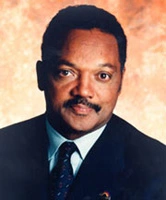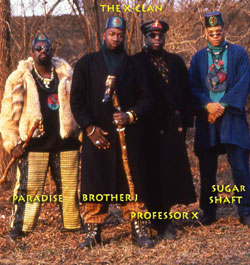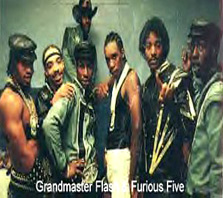
Tyler Perry
Movie mogul Tyler Perry is on fire. His new movie Temptation was bigger-than-projected. It opened at $22.3 million making it Perry’s second-biggest opening non-Madea movie after the sequel Why Did I Get Married Too?. Tyler said he’s happy with his latest efforts and feels it was big comeback after the set backs and harsh criticism he received with the thriller Alex Cross and his own Good Deeds.
As for future projects Perry announced that he’s teamed up with the History Channel which is coming off a huge ratings success with their mini-series The Bible. The network announced it was their most watched series to date and they are excited to team up with Perry to do several miniseries that highlight and chronicle African-American life. History Channel executives were impressed how Perry gave new life to the iconic play For Colored Girls Only....and feel he can bring similar success to the network.

DJ Kool Herc
The first scheduled project will be an epic miniseries on the birth of Hip Hop which celebrates its 40th anniversary this year. History notes on August 11th 1973 in the South Bronx at a community center located inside 1520 Sedgwick Avenue, Clive Campbell better known as DJ Kool Herc along with his sister Cindy threw a back to school dance to raise money for school clothes. The pair who had newly arrived from Jamaica and brought with them a new style of deejaying which included using a massive sound system and doing early raps then called chants over instrumental dub plates. This is how Hip Hop was born.
Perry acknowledged that he grew up on Hip Hop and always wanted to see this story come to life and be told correctly. “A lot of people don’t know, that I’m what you would call a true Hip Hop head. I love rap. I love Hip Hop and I want to do this right…. Doing this series on the History Channel in the same vein as the Bible series will give Hip Hop the true academic validation that has alluded it all these past 4 decades.”

Bible Miniseries producers Roma & Mark
Roma Downey and Mark Burnett the brains and key architects behind the Bible miniseries have been tapped to produce the Hip Hop miniseries which is tentatively titled ‘40 Years The True Story of Hip Hop‘. Although they are not Hip Hop ‘experts’, they are Biblical experts and in Hip Hop in many respects parallels the trajectory of events in the Bible. History Channel executives felt it was important to tap into their talents so that they can give the True Story of Hip Hop an exciting and larger-than-life cinematic epic feel.
Perry stated ‘These guys are great writers and have tremendous passion and vision..What we have done is amassed a panel of Hip Hop experts including Chicago State scholars Frank Chitterbang and Sam Socrates who founded the nation’s first Hip Hop studies program last year.
“We need to celebrate and honor them for being the first to bring Hip Hop to academia” Perry said. Hip Hop needs to be studied. This miniseries will help underscore that point.
Other Hip Hop experts to be tapped for the Perry/ History Channel Hip Hop project include; Civil Rights icon Jesse Jackson and Reverend T.D. Jakes.
Why Church folks? some may ask…

Jesse Jackson
“In telling the story of Hip Hop we have to be honest and go to the true source”, Perry noted. “Hip Hop didn’t start in some dirty run down ghetto. It started in the church. The first rappers were preachers.
The young bucks at the first party DJ Kool Herc gave were emulating their elders from the church by doing what we call in the African tradition ‘Call and Response’. Dr Martin Luther King who Reverend Jackson marched with was the first true emcee..His cadence, his swag, his message is what inspired early Hip Hop.. That’s real talk. We gotta own up to this.. We gotta know our true history”.
It should also be noted that Jesse Jackson was the first Civil Rights Icon Hip Hop paid tribute to, when Grandmaster Flash did a song about him called Jesse to commemorate his historic 1984 run for President.
http://www.youtube.com/watch?v=V3IsCfMB0rk
Perry noted that to keep everyone honest and this series truly authentic, they are inviting the owners of the Hip Hop’s biggest websites like World Star, Bossip, and AHH to name a few to offer advice and help guide the miniseries.
In terms of casting, Perry noted that he and the History Channel were meticulous in their eventual selection. Former wrestler turned actor Dwayne Johnson better known as The Rock’ will play DJ Kool Herc. Both men have similar physics.

Don Cheadle to play GM Flash
Comedian Anthony Anderson will play Big Bank Hank of the Sugar Hill Gang
Cedric the Entertainer will play Hip Hop pioneer Afrika Bambaataa.
House of Lies actor Don Cheadle will play pioneer Grandmaster Flash.
Chris Brown is being cast to play a young brash LL Cool J.
Coming off rave reviews and the success of Temptation, reality TV star who is now making major headway into Hollywood as an actress of note, Kim Kardashian will be tapped to play Salt of Salt-N-Pepa one of Hip Hop’s first female emcees.
Perry noted that her boyfriend Kanye West is being asked to help show her some pointers on how to rap.. ‘She will do this important role and the miniseries justice’ Perry added.

Kim Kardashian
Pepa will be played by Janet Jackson who is a favorite in Perry movies
History Channel executives are being tight-lipped about other roles, but from the looks of things this promises to be an all-star cast.
Perry noted that its important to keep in mind Hip Hop is inclusive. Its a bout building community. It’s in that spirit they are opening their doors doing a nationwide casting call for those involved in Hip Hop and can do a little of acting. They are also looking for Hip Hop experts who are knowledgeable about local Hip Hop history from their respective cities..If you would like to be part of the Hip Hop miniseries you can get more information by clicking HERE..
In case you don’t know…
 This is an important conversation where Hip Hop pioneer Grand Wizzard Theodore speaks for himself and explains the origins of the Scratch.. Up to that point, many had come to believe that Theodore was trained by Grandmaster Flash who started off in a crew called the L-Brothers (L=Livingston which is Theodore’s last name). I recall interviewing Flash back in 1996 at length and he broke all this down..noting that Theodore was his student..
This is an important conversation where Hip Hop pioneer Grand Wizzard Theodore speaks for himself and explains the origins of the Scratch.. Up to that point, many had come to believe that Theodore was trained by Grandmaster Flash who started off in a crew called the L-Brothers (L=Livingston which is Theodore’s last name). I recall interviewing Flash back in 1996 at length and he broke all this down..noting that Theodore was his student.. The other unintended story that needed to be put to rest was Theodore spilling beer on a turntable and inventing the scratch while wiping the record clean.. This came about after a humorous Heineken commercial aired a few years back depicting that. It was part of a series of commercials the beer company did where they fictionalized how the accidents around the beer created the Peace sign, the Lighter, the scratch etc.. Unfortunately because there had been so much historical distortion around the legacy of Theodore, many didn’t find the humor in the commercial resulting in an open letter and protest to the beer company.
The other unintended story that needed to be put to rest was Theodore spilling beer on a turntable and inventing the scratch while wiping the record clean.. This came about after a humorous Heineken commercial aired a few years back depicting that. It was part of a series of commercials the beer company did where they fictionalized how the accidents around the beer created the Peace sign, the Lighter, the scratch etc.. Unfortunately because there had been so much historical distortion around the legacy of Theodore, many didn’t find the humor in the commercial resulting in an open letter and protest to the beer company.
 This past Monday, Spinderella of Salt-N-Pepa, Mike Shinoda of Linkin Park and myself among others, participated in a panel discussion at UCLA that focused on the business workings and current state of Hip Hop. Before we launched into Q&A from the audience all of us were asked ‘What CD we were listening to in our ride?’ The audience seemed a bit surprised when I mentioned that in my CD deck was the 1981 album ‘JuJu’ by new wave/punk act Siouxsie & the Banshees. Songs like ‘Spellbound, ‘Monitor’ and ‘Into the Light’ brought back fond memories. More importantly the whole early new wave/punk scene was a very much apart of my early Hip Hop experience.
This past Monday, Spinderella of Salt-N-Pepa, Mike Shinoda of Linkin Park and myself among others, participated in a panel discussion at UCLA that focused on the business workings and current state of Hip Hop. Before we launched into Q&A from the audience all of us were asked ‘What CD we were listening to in our ride?’ The audience seemed a bit surprised when I mentioned that in my CD deck was the 1981 album ‘JuJu’ by new wave/punk act Siouxsie & the Banshees. Songs like ‘Spellbound, ‘Monitor’ and ‘Into the Light’ brought back fond memories. More importantly the whole early new wave/punk scene was a very much apart of my early Hip Hop experience.



 It’s one sided in the sense that you have rock oriented outlets with a predominantly white audience embracing Hip Hop. Yes, you can tune into a radio station like KROQ and hear rap alongside the usual rock offerings and lastly we have all the mash up projects, with the most noticeable being Collision Course with Linkin Park and Jay-Z. However, you will not see similar attempts in many urban outlets that target African American audiences. Yes believe it or not groups like Linkin Park as popular as they are are still relatively unknown in many Black circles where BET and commercial radio are the main conduits to things outside the community. I’m not sure what needs to be done to change that or if it even needs to be changed.
It’s one sided in the sense that you have rock oriented outlets with a predominantly white audience embracing Hip Hop. Yes, you can tune into a radio station like KROQ and hear rap alongside the usual rock offerings and lastly we have all the mash up projects, with the most noticeable being Collision Course with Linkin Park and Jay-Z. However, you will not see similar attempts in many urban outlets that target African American audiences. Yes believe it or not groups like Linkin Park as popular as they are are still relatively unknown in many Black circles where BET and commercial radio are the main conduits to things outside the community. I’m not sure what needs to be done to change that or if it even needs to be changed.



 Kool DJ Herc, originally from Jamaica, is credited with extending these breaks by using two turntables, a mixer and two of the same records. As DJs could re-cue these beats from one turntable to the other, finally, the dancers were able to enjoy more than just a few seconds of a break! Kool Herc also coined the terms “b-boy” and “b-girl” which stood for “break boys” and “break girls.” At one of Kool Herc’s jams, he might have addressed the dancers just before playing the break beats by saying, “B-Boys are you ready?! B-Girls are you ready?!” The tension started to mount and the air was thick with anticipation. The b-boys and b-girls knew this was their time to “go off!”
Kool DJ Herc, originally from Jamaica, is credited with extending these breaks by using two turntables, a mixer and two of the same records. As DJs could re-cue these beats from one turntable to the other, finally, the dancers were able to enjoy more than just a few seconds of a break! Kool Herc also coined the terms “b-boy” and “b-girl” which stood for “break boys” and “break girls.” At one of Kool Herc’s jams, he might have addressed the dancers just before playing the break beats by saying, “B-Boys are you ready?! B-Girls are you ready?!” The tension started to mount and the air was thick with anticipation. The b-boys and b-girls knew this was their time to “go off!” “Power moves” is a debatable term since it is questionable which movement requires more power: footwork and freezes or spins and gymnastics. One notable point introduced by B-Boy Ken Swift is that spins are fueled by momentum and balance which require less muscular strength than footwork and freezes. The laws of physics prove this to be true: spins require speed and speed creates momentum. The advent of “power moves” brought about a series of spins which became the main focus of the media and the younger generations of dancers. The true essence of the dance was slowly overshadowed by an over abundance of spins and acrobatics which didn’t necessarily follow a beat or rhythm. The pioneers didn’t separate the “power moves” from the rest of the dance form. They were B-Boys who simply accented their performance with incredible moves to the beat of the music.
“Power moves” is a debatable term since it is questionable which movement requires more power: footwork and freezes or spins and gymnastics. One notable point introduced by B-Boy Ken Swift is that spins are fueled by momentum and balance which require less muscular strength than footwork and freezes. The laws of physics prove this to be true: spins require speed and speed creates momentum. The advent of “power moves” brought about a series of spins which became the main focus of the media and the younger generations of dancers. The true essence of the dance was slowly overshadowed by an over abundance of spins and acrobatics which didn’t necessarily follow a beat or rhythm. The pioneers didn’t separate the “power moves” from the rest of the dance form. They were B-Boys who simply accented their performance with incredible moves to the beat of the music. In Los Angeles, California, Don Campbell, also known as Don Cambellock, originated the dance form “locking.” Trying to imitate a local dance called the “funky chicken,” Don Campbell added an effect of locking of the joints of his arms and body which became known as his signature dance. He then formed a group named “The Lockers,” who all eventually shared in the development of this dance. The steps and moves created by these pioneers were named and cataloged. Some of these include: the lock,points, skeeters, scooby doos, stop n’go,which-away and the fancies. Certain members of The Lockers” incorporated flips, tucks, dives and other aerial moves reminiscent of the legendary Nicholas Brothers. The main structure of the dance combined sharp, linear limb extensions and elastic-like movement.
In Los Angeles, California, Don Campbell, also known as Don Cambellock, originated the dance form “locking.” Trying to imitate a local dance called the “funky chicken,” Don Campbell added an effect of locking of the joints of his arms and body which became known as his signature dance. He then formed a group named “The Lockers,” who all eventually shared in the development of this dance. The steps and moves created by these pioneers were named and cataloged. Some of these include: the lock,points, skeeters, scooby doos, stop n’go,which-away and the fancies. Certain members of The Lockers” incorporated flips, tucks, dives and other aerial moves reminiscent of the legendary Nicholas Brothers. The main structure of the dance combined sharp, linear limb extensions and elastic-like movement. In 1976, The Electronic Boogaloo Lockerswas formed in Fresno, California by Sam “Boogaloo Sam” Soloman, Nate “Slide” Johnson and Joe “Slim” Thomas. Since the group’s inception, Sam has continued to recruit and help each member master his individual form. Some of Sam’s early inspirations were Chubby Checker‘s “Twist;” a James Brown dance called “the Popcorn;” “the Jerk;” cartoon animation and the idiosyncrasies of everyday people. From these many influences, Sam combined incredible steps and moves conceiving a dance form which he named “Boogaloo.” This form includes isolated sharp angles, hip rotations and the use of every part of the body. Sam’s brother, Timothy “Popin’ Pete” Soloman, described Boogaloo as a dance which was done by moving the body continuously in different directions.
In 1976, The Electronic Boogaloo Lockerswas formed in Fresno, California by Sam “Boogaloo Sam” Soloman, Nate “Slide” Johnson and Joe “Slim” Thomas. Since the group’s inception, Sam has continued to recruit and help each member master his individual form. Some of Sam’s early inspirations were Chubby Checker‘s “Twist;” a James Brown dance called “the Popcorn;” “the Jerk;” cartoon animation and the idiosyncrasies of everyday people. From these many influences, Sam combined incredible steps and moves conceiving a dance form which he named “Boogaloo.” This form includes isolated sharp angles, hip rotations and the use of every part of the body. Sam’s brother, Timothy “Popin’ Pete” Soloman, described Boogaloo as a dance which was done by moving the body continuously in different directions.












